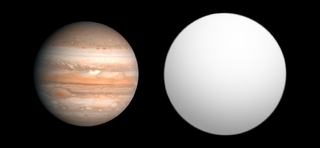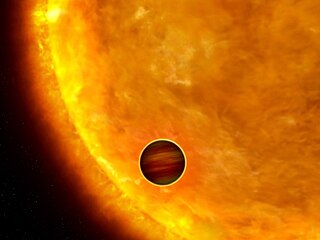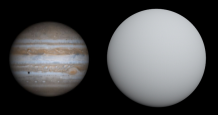Related Research Articles

An exoplanet or extrasolar planet is a planet outside the Solar System. The first possible evidence of an exoplanet was noted in 1917 but was not recognized as such. The first confirmation of detection occurred in 1992. A different planet, initially detected in 1988, was confirmed in 2003. As of 1 July 2023, there are 5,425 confirmed exoplanets in 4,001 planetary systems, with 868 systems having more than one planet. The James Webb Space Telescope (JWST) is expected to discover more exoplanets, and also much more about exoplanets, including composition, environmental conditions and potential for life.

CoRoT was a space telescope mission which operated from 2006 to 2013. The mission's two objectives were to search for extrasolar planets with short orbital periods, particularly those of large terrestrial size, and to perform asteroseismology by measuring solar-like oscillations in stars. The mission was led by the French Space Agency (CNES) in conjunction with the European Space Agency (ESA) and other international partners.
A super-Jupiter is a gas giant exoplanet that is more massive than the planet Jupiter. For example, companions at the planet–brown dwarf borderline have been called super-Jupiters, such as around the star Kappa Andromedae.

Chthonian planets are a hypothetical class of celestial objects resulting from the stripping away of a gas giant's hydrogen and helium atmosphere and outer layers, which is called hydrodynamic escape. Such atmospheric stripping is a likely result of proximity to a star. The remaining rocky or metallic core would resemble a terrestrial planet in many respects.

Hot Jupiters are a class of gas giant exoplanets that are inferred to be physically similar to Jupiter but that have very short orbital periods. The close proximity to their stars and high surface-atmosphere temperatures resulted in their informal name "hot Jupiters".
This page describes exoplanet orbital and physical parameters.

CoRoT-3b is a brown dwarf or massive extrasolar planet with a mass 21.66 times that of Jupiter. The object orbits an F-type star in the constellation of Aquila. The orbit is circular and takes 4.2568 days to complete. It was discovered by the French-led CoRoT mission which detected the dimming of the parent star's light as CoRoT-3b passes in front of it.

CoRoT-6b is an exoplanet that was reportedly discovered by the CoRoT mission team on February 2, 2009, orbiting the F type star CoRoT-6. It is located in the Ophiuchus constellation.

CoRoT-1 is a yellow dwarf main sequence star similar to the Sun. The star is located approximately 2,630 light-years away in the constellation of Monoceros. The apparent magnitude of this star is 13.6, which means it is not visible to the naked eye; however, it can be seen through a medium-sized amateur telescope on a clear, dark night. The first exoplanet discovered in the course of the CoRoT mission orbits this star; it is considered to be a "hot Jupiter", and is approximately as massive as the planet Jupiter itself.
CoRoT-6 is a magnitude 13.9 star located in the Ophiuchus constellation.

Kepler-10, formerly known as KOI-72, is a Sun-like star in the constellation of Draco that lies 607 light-years from Earth. Kepler-10 was targeted by NASA's Kepler spacecraft, as it was seen as the first star identified by the Kepler mission that could be a possible host to a small, transiting exoplanet. The star is slightly less massive, slightly larger, and slightly cooler than the Sun; at an estimated 11.9 billion years in age, Kepler-10 is almost 2.6 times the age of the Sun. Kepler-10 is host to a planetary system made up of at least three planets. Kepler-10b, the first undeniably rocky planet, was discovered in its orbit after eight months of observation and announced on January 10, 2011. The planet orbits its star closely, completing an orbit every 0.8 days, and has a density similar to that of iron. The second planet, Kepler-10c, was confirmed on May 23, 2011, based on follow-up observations by the Spitzer Space Telescope. The data shows it has an orbital period of 42.3 days and has a radius more than double that of Earth, but it was initially thought to have a higher density, making it the largest and most massive rocky planet discovered as of June 2014. However, refined mass measurements have shown it to be a more typical volatile-rich planet. A third planet, Kepler-10d, was discovered in 2023 by radial velocity observations.
CoRoT-21b is a transiting exoplanet reportedly found by the CoRoT space telescope in 2011. Planetary parameters were published in 2012.
CoRoT-11b is a transiting Hot Jupiter-sized exoplanet found by the CoRoT space telescope in 2010.
CoRoT-14b is a transiting Hot Jupiter exoplanet found by the CoRoT space telescope in 2010.

CoRoT-16b is a transiting exoplanet orbiting the G or K type main sequence star CoRoT-16 2,433 light years away in the southern constellation Scutum. The planet was discovered in June 2011 by the French-led CoRoT mission.
CoRoT-17b is a transiting Hot Jupiter exoplanet found by the CoRoT space telescope in 2011.
CoRoT-18b is a transiting Hot Jupiter exoplanet found by the CoRoT space telescope in 2011.
CoRoT-20b is a transiting exoplanet found by the CoRoT space telescope in 2011.
CoRoT-23b is a transiting exoplanet found by the CoRoT space telescope in 2011.
Planet-hosting stars are stars which host planets, therefore forming planetary systems.
References
- 1 2 3 "Notes on CoRoT-13 b" . Retrieved 20 November 2016.
- ↑ Cabrera, J.; et al. (2010). "Transiting exoplanets from the CoRoT space mission XIII. CoRoT-13b: a dense hot Jupiter in transit around a star with solar metallicity and super-solar lithium content". Astronomy and Astrophysics. 522. A110. arXiv: 1007.5481 . Bibcode:2010A&A...522A.110C. doi:10.1051/0004-6361/201015154.